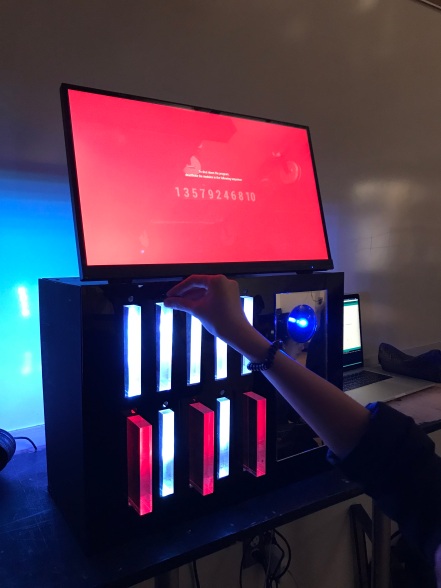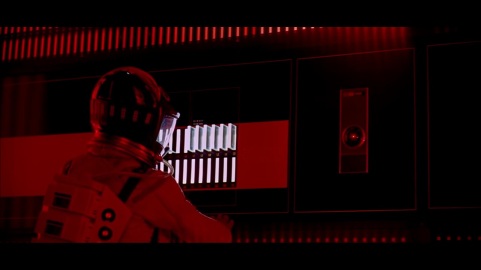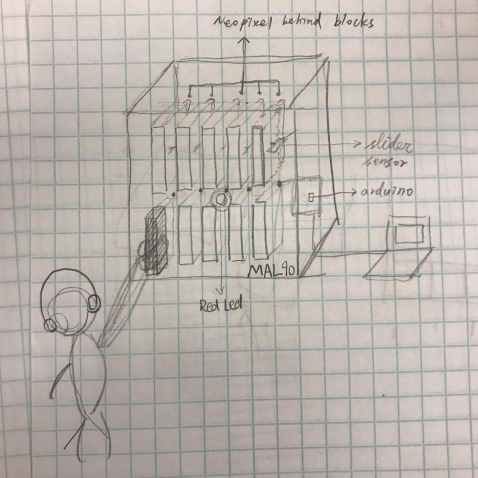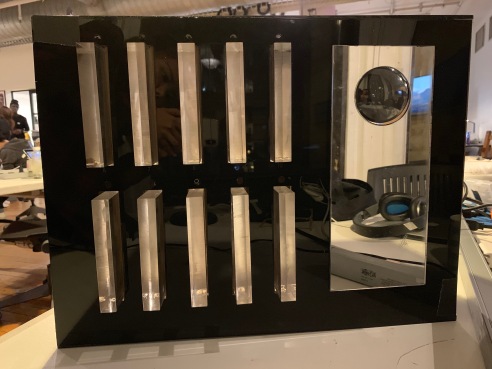My final is a collaborative project with Vince and Yves, combining Physical Computing, ICM, and Code of Music. It is an interactive voice/sound installation about a future AI therapy program – Jane.

Inspiration: our first inspiration for the project came from a scene from the movie 2001: A Space Odyssey, where David was shutting down the AI HAL by extracting the modules from the wall as it threatened the ship crew’s life. So we played with the idea of the downside of AI technology and started to build our own story around it.

Ideation, playtest & iteration:
Our first idea was simply a sound machine, the sound would start off very pleasant in the first half, just like when AI technology was first created, it was praised to be very helpful and smart. As the sound progresses, it becomes more chaotic and uncontrollable, as a metaphor that when AI technology matures, a lot of moral issues start to emerge and may come to a point where it goes beyond human control. The sound would then make the user feel compelled to shut down the machine.
However, through discussion, we agreed that the first idea lacks meaningful interaction, if it is just playing sound and users will be able to activate and deactivate by inserting and extracting the module, then it would be just like replicating the movie scene.

So we came up with a second idea – an interactive story-telling installation, a machine that “speaks”. Similar to “Choose Your Own Adventure” gamebooks, users will receive different visual/audio feedback based on the path they choose. Therefore, we created an AI character that prevents emotional illness through sound therapy. AI will prompt the user to activate the sound modules in the first half, then the AI will reveal that the best way to prevent emotional illness is to eliminate all the emotions. The emergency instruction will pop out, users can follow the sequence on the instruction to deactivate the machine.
From our first round of playtesting with a cardboard box and manually triggering sound clips based on users’ actions, 100% of the users chose to shut down the machine with the instruction provided. The result came out more predetermined than “Choose Your Own Adventure”. We observed users actions and collected feedback and concluded the reason behind the skewed result was 1. hearing that their emotions will be eliminated from a threatening machine voice, no one would just obediently let it happen; 2. the emergency instruction popping out from the box was too compelling that user felt it was imperative that they follow.

We brainstormed how we could make changes to the story to balance the results. In the third version, we changed the plot twist from AI eliminating emotions to uploading user’s mind to a perfect simulation. This time, the AI will sound way more nice and friendly. We will also give the emergency instruction to the user at the beginning instead of having it built in and pop out from the middle.
Based on the revised script, we named the AI Jane. I made a virtual interface of the physical interaction in the browser(code linked below) and used it to playtest further while the physical box was still under construction. And this time, we had the opposite result from the first round. Instead of everyone shutting down the machine, 80% of the users did nothing after the plot twist and just sat there and had their minds “uploaded”. The result was still skewed, but we gathered the most useful feedback on why or why not they would deactivate the machine and iterated accordingly.
Observation 1: users had no reaction at all during deactivation stage because
a) they forgot about emergency instruction provided in the beginning.
b) they knew mind uploading is unreal, they did not feel threatened by Jane’s words, instead, were curious to know what’s happening next.
c) the plot twist was not obvious and did not sound sinister enough to make them feel threatened.
Observation 2: users attempted to deactivate following the emergency instruction before the plot twist where they were not supposed to deactivate.
Observation 3: users attempted to activate/deactivate the modules while modules were locked as Jane was talking but there was no feedback and user got confused.
Observation 4: users found it hard to focus on the redundant voice clips for a long time, some even started to check their phones during the interaction.
Observation 5: Some users who chose to have their minds “uploaded” explained they waited a long time and built up high expectations to find out what would happen but was disappointed by the abrupt ending when Jane just congratulated user and ended the session.
Observation 6: out of the users that did attempt deactivation, they tried their best to follow the sequence to deactivate Jane. They felt tension at this stage because the uploading timer started and Jane was uploading users “minds” step by step, and they felt like they were fighting it.
Having rounds after rounds of playtests, we concluded: 1) users who deactivated Jane were somehow excited by the urgency when Jane was uploading their minds but they only had limited amount of time left to save themselves from being uploaded. They also enjoyed the tension of resisting against Jane as she persuaded them to stay every time they managed to deactivate a module. 2) as for the users who waited to see what would happen after Jane finished uploading, they felt not impressed and convinced by the ending, because they knew mind-uploading was not real as much as they were not emotionally invested in the plot to believe in Jane. Therefore this path of the story is less interactive and interesting.
So we decided we need to go back to our earlier version of the interaction where we would make Jane’s intention and voice more hostile to provoke users to deactivate, as well as having a prominent emergency instruction to compel the users to follow. Therefore, we focused on gamifying the whole interaction to make deactivation stage the core interaction of the game. The goal was to get users to fight against Jane while Jane is counting down the stages left till mind upload. If users complete the sequence before uploading steps are completed, they win.
With the new goal in mind, we refined the script and improved the interface by changing the timing of displaying the deactivation sequence back to the point where Jane reveals her true intention. We wanted to have it built inside the box, popping out from the side, but at this point, it was too late to restructure the almost-finished box. So we decided to have it displayed on a separate screen with alarming color indicating malfunction so users will not forget about the option to deactivate when it is time for them to do so and it will also avoid the situation where some users attempt to deactivate in the beginning. We also enhanced visual feedback on the led strips when buttons are locked at certain points when Jane is talking.
Finalized user flow:
- user comes in with key provided, reads the waiver, puts on headphones, taps “start session” button on the touchscreen on top of the box.
- Jane greets user explains she will analyze user’s brain activity during the session and prompts the user to activate modules.
- Jane starts to play sound and chats with user.
- When the 10th module is activated, Jane reveals that the current reality is so corrupted that she will put user into sleep and upload user’s mind into a perfect world.
- Emergency deactivation instruction lights up while Jane starts her uploading process, and counts down the seconds left till uploading.
- User follows the deactivation sequence to shut down the system before the uploading process is completed.
Code:
Arduino w/ Serial Communication: https://github.com/vince19972/itp_pcomp-final/blob/stable-version-update/arduino-main/arduino-main.ino
P5 sketch w/ Serial Communication: https://github.com/vince19972/itp_pcomp-final/tree/stable-version-update/serial-communication
P5 virtual interface for playtest: https://github.com/ada10086/itp_pcomp-final/tree/develop/MAL_user_test
Jane’s voice generator:
https://www.naturalreaders.com
Project flow and work division:
Throughout the whole process, we had multiple tasks happening at the same time.
Before we had our plot figured out, we treated it as an industrial design assignment and started the construction of the box regardlessly knowing that physical engineering is the most challenging part. For details on fabrication and circuit components setup, refer to my PCOM blog.
We all worked together on the box construction following the initial 2D and 3D design plan made by Vince and on building the circuit based on the schematics I drew. Later Yves was overlooking the production and improvement of the physical look of the box.
We discussed the plot together and I wrote the first version script for Jane’s voice, exported from the voice generator, and gathered sound clips for therapy. For the virtual interface for playtest, I programmed all the voice clips using P5 sound, manipulated the sound clips and created sound effects using Tone.js.
Utilizing the virtual interface, we did numerous rounds of playtesting in 5 different classes and kept on testing and refining the script and changing the sound according to our observations.
While playtest and construction were happening, Vince programmed Arduino with a state machine. We later sat together to integrate our Arduino and p5 code with serial communication.
Towards the end, we all worked together to polished both the box and the script and debug our code.

Class demo with volunteer user:
Demo interaction with test voice clips:
Takeaway:
In the beginning, we were playtesting with just a cardboard box. It was very painful and hard to predict and control things manually. And people did not get enough visual feedback. However, the box was a huge engineering process and took forever to build. We couldn’t wrap our head around the power supply issue and wiring our circuit until the week before final presentation so we were never able to playtest with a physically functional prototype.
Therefore, the virtual interface came in extremely helpful during playtest. As voice and sound are the heart of the project and what the whole interaction is built around, we couldn’t have tested them without it and gathered so many useful results to iterate our concept.
Defining the purpose and having that goal of the project in mind is very important in building the whole project, as what the project does defines the core interaction. Is it a storytelling installation, an instrument, a meditative sound environment, or a game? We tried to do too many things at once in a limited amount of time and we got lost in the process, struggling to make every part perfect as its own project, the sound design, the voice script, the plot, the physical mechanism, and sometimes they don’t necessarily go well with each other without a clear goal defined. Thanks to numerous rounds of playtesting, we narrowed down our focus to a game piece. And once the conceptual idea was fixed, we were no longer stuck on ideation and was able to just focus on the hardware and software design that serve best for the purpose.
Winter show comments:
Although there were still some minor software bugs in our program during the show, like sending serial data back to Arduino to lock the button and change the color of LED strips at the correct timing, we managed to present Jane as a future AI therapist with evil intention. People were so intrigued by how futuristic and mysterious the box looked and curious to find out what this box does. They enjoyed the satisfying process to insert the key and watch modules sliding in and out with beautiful changing lights. Many of them also expressed how they loved the concept of borrowing the interface from a classic sci-fi movie and turn it into a game with a different story.
Winter show footage:

